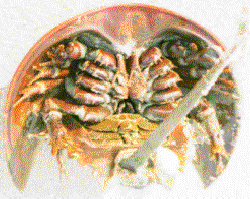| The head and thorax of the horseshoe crab are fused together to make the cephalothorax. The body is covered with a hard, thick shell. The abdomen is protected by a narrow shell that is hinged from the main shell at the front and ends in a long, sharp spine attached to the back. The animal has a large compound eye on each side of the cephalothorax, two pairs of smaller, simple eyes between the compound eyes, Its mouth is located in the middle of the underside of the cephalothorax. A pair of pincers for seizing food are found on each side of the mouth. The horseshoe crab has six pairs of walking legs. The underside of the abdomen bears six additional pairs of appendages; the first covers the genital opening, the other five are modified as gills. It feeds on small invertebrates that are buried beneath sand or mud. "In late spring the female lays eggs in the intertidal zone of bays and estuaries. |

